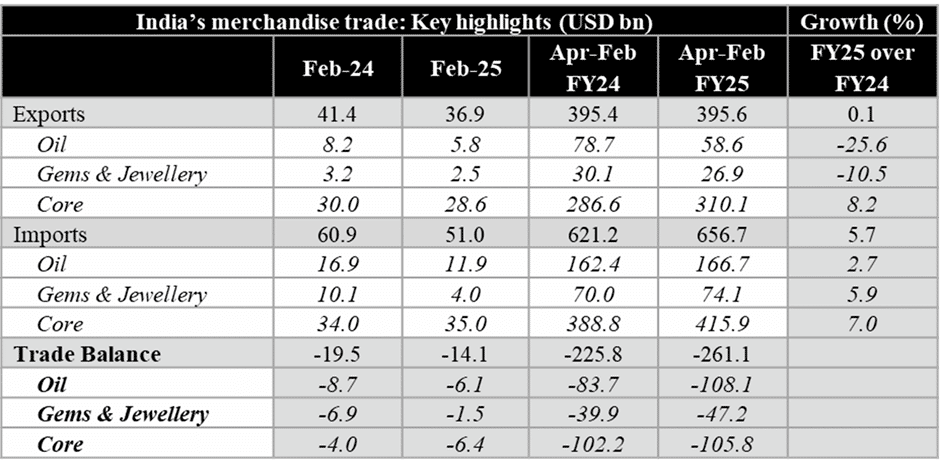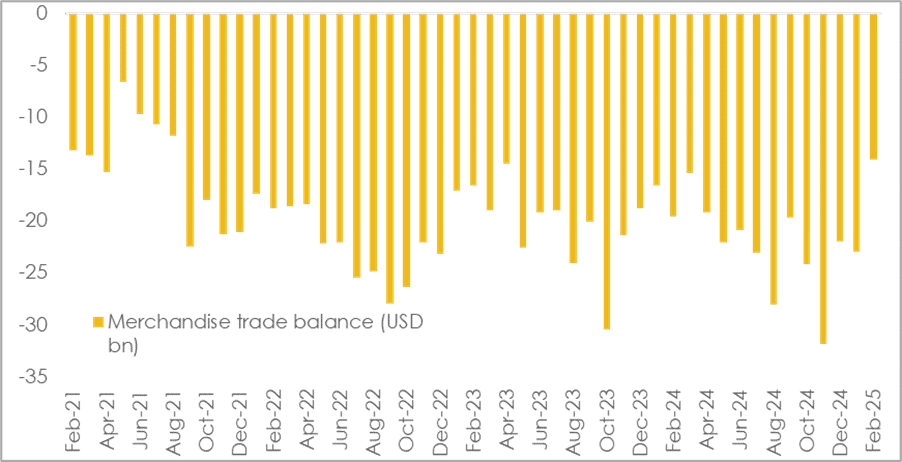19 Mar 2025
Merchandise Exports Merchandise exports rose to USD 36.9 bn in Feb-25 from USD 36.4 bn (+1.3% MoM and -10.9% YoY) in Jan-25 Merchandise Imports Merchandise Imports moderated to a 22-month low of USD 51.0 bn in Feb-25 from USD 59.4 bn (-14.2% MoM and -16.3% YoY) in Jan-25 Merchandise Trade balance Services Trade The estimate for services trade surplus for Feb-25 stands at USD 18.5 bn compared to USD 18.0 bn in Jan-25. While exports expanded by 0.9% MoM, imports recorded a correction of a similar magnitude. On an Apr-Feb FYTD basis, the services trade surplus has continued to grow at a healthy pace of 15.0% YoY. Services exports have remained resilient, benefitting from the continuing strength in the US economy so far, along with the proliferation of Global Capability Centres in India that have helped to diversify exports beyond the traditional IT services. Having said that, the likely downside to US GDP growth from an aggressive use of tariffs is a potential risk going into FY26. Outlook For FY25, we lower our current account deficit estimate to 0.7% of GDP from 1.2% of GDP, reflecting a downside bias. The favourable Feb-25 print, recent revision in data on account of computational discrepancy as well as the strength in services trade surplus prompts this revision. For FY26, a lot on the trade front rides on geopolitics and the evolution of trade flows from here on, especially with the imposition of reciprocal tariffs by the US beginning Apr-25. It is comforting to note that India and the US have displayed camaraderie at PM Modi’s recent visit to the US, promising to strengthen economic ties and enhance bilateral trade, especially in sectors of energy, defence and technology. Specifically, the two nations will be working towards “Mission 500” – aiming to more than double total bilateral trade to USD 500 bn by 2030 and negotiate the first tranche of the multi-sector Bilateral Trade Agreement (BTA) as early as the fall of 2025. In the interim, India might be exploring some other ‘quick fixes’, such as – 1) Fixing a certain quantum or quota of its total oil imports for sourcing crude from the US and 2) Identifying a list of items where India is willing to reduce/eliminate tariffs to push a ‘zero for zero’ tariff regime. As such, trade remains a developing story to watch, especially with respect to India’s negotiations with respect to reciprocal tariffs in the very near term. Additionally, Brent prices, which have been benign in the USD 71-72 per barrel range of late, remain on watch for any upside if geopolitics were to escalate. Gold prices, in an environment of global uncertainty, continue to scale record highs. As such, we hold on to our FY26 current account deficit of 1.3% of GDP with a wide range of two-sided risks. Rupee Outlook The US dollar’s initial rally that propelled the DXY index from its pre-election low of 100.4 in Sep-24 to 110.0 in Jan-25 was predicated on the prevailing US economic resilience, which coupled with Trump’s anticipated policy changes, was expected to preserve the narrative of US exceptionalism. However, this narrative now appears to be running out of steam, and the USD is facing some headwinds. An authoritarian approach towards the imposition of tariffs is clouding the US economic outlook: Although India has not attracted any targeted tariffs yet, overtures from the US administration suggest a strong likelihood of imposition of reciprocal tariffs from April 25. As such, INR has been one of the worst-performing currencies on a CYTD basis, depreciating by 1.2% against the USD. Notably, the CYTD weakness in INR has played out in the backdrop of a 4.7% drop in the DXY index. However, there are a few domestic factors which are also playing a minor role at the same time. Having said that, we do note the emergence of a few silver linings. Overall, notwithstanding elevated known-unknown risks, we maintain our USDINR call of 87.50 for Mar-25 while expecting further depreciation towards 89.50 before Mar-26. Below is Acuité Ratings & Research Limited's comment on the Feb 2025 Trade data: “India’s trade outlook presents a mixed picture. The narrowing trade deficit offers near-term relief, but soft global demand and lower commodity prices may continue to weigh on exports. Core imports show signs of resilience, reflecting some stability in domestic demand, while the services trade surplus is expected to remain strong due to demand. However, risks persist from geopolitical tensions and shifts in US economic policy. The external sector’s trajectory in FY26 will hinge on the pace of global recovery and India’s policy measures to navigate these uncertainties in the current tariff war.” *Note: Numbers may not add up due to rounding off and revision in headline exports and imports Chart 1: Trade balance records a sizeable narrowing in Feb-25, led by correction in imports
India’s merchandise trade deficit narrowed sizably to USD 14.1 bn in Feb-25 – a 42-month low, from USD 23.0 bn in Jan-25. This was single-handedly driven by a sequential correction in imports, even as exports posted a marginal sequential increase.
KEY TAKEAWAYS
Table 1: Highlights of India’s trade balance*
